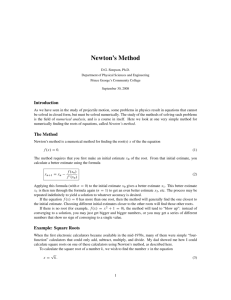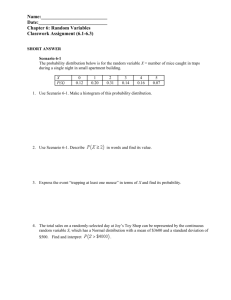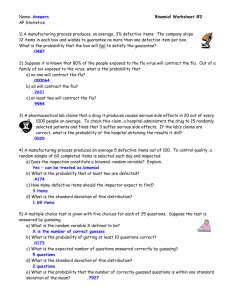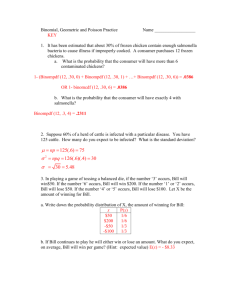Samples, Bias, & Survey Design
advertisement
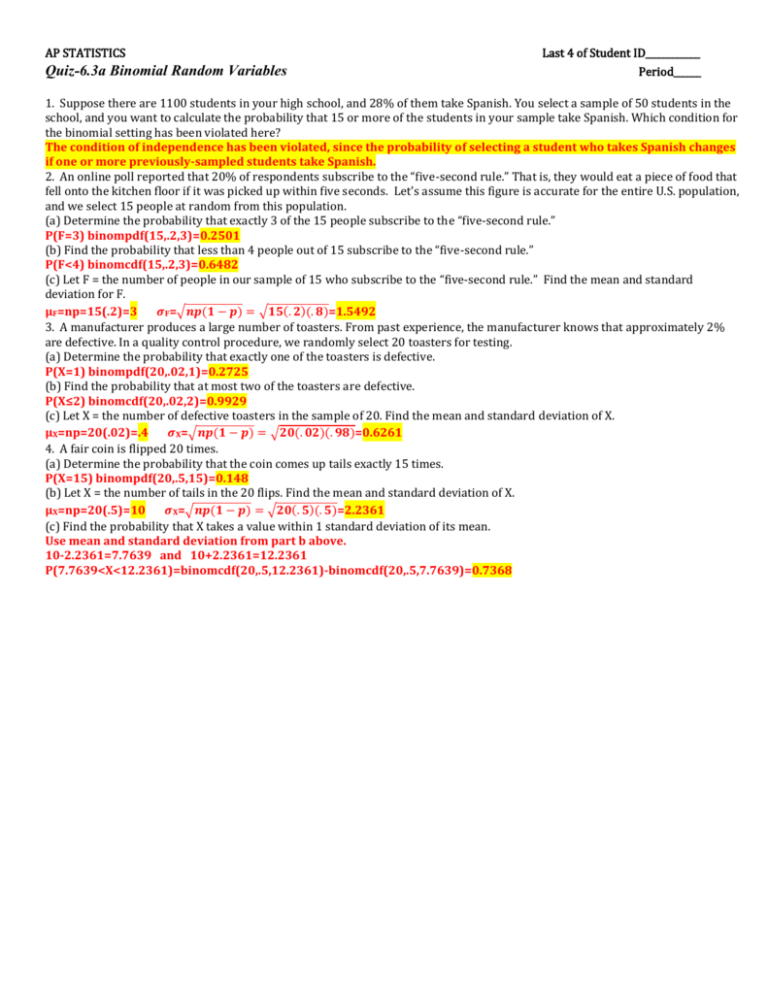
AP STATISTICS Quiz-6.3a Binomial Random Variables Last 4 of Student ID____________ Period______ 1. Suppose there are 1100 students in your high school, and 28% of them take Spanish. You select a sample of 50 students in the school, and you want to calculate the probability that 15 or more of the students in your sample take Spanish. Which condition for the binomial setting has been violated here? The condition of independence has been violated, since the probability of selecting a student who takes Spanish changes if one or more previously-sampled students take Spanish. 2. An online poll reported that 20% of respondents subscribe to the “five-second rule.” That is, they would eat a piece of food that fell onto the kitchen floor if it was picked up within five seconds. Let’s assume this figure is accurate for the entire U.S. population, and we select 15 people at random from this population. (a) Determine the probability that exactly 3 of the 15 people subscribe to the “five-second rule.” P(F=3) binompdf(15,.2,3)=0.2501 (b) Find the probability that less than 4 people out of 15 subscribe to the “five-second rule.” P(F<4) binomcdf(15,.2,3)=0.6482 (c) Let F = the number of people in our sample of 15 who subscribe to the “five-second rule.” Find the mean and standard deviation for F. µF=np=15(.2)=3 𝝈F=√𝒏𝒑(𝟏 − 𝒑) = √𝟏𝟓(. 𝟐)(. 𝟖)=1.5492 3. A manufacturer produces a large number of toasters. From past experience, the manufacturer knows that approximately 2% are defective. In a quality control procedure, we randomly select 20 toasters for testing. (a) Determine the probability that exactly one of the toasters is defective. P(X=1) binompdf(20,.02,1)=0.2725 (b) Find the probability that at most two of the toasters are defective. P(X≤2) binomcdf(20,.02,2)=0.9929 (c) Let X = the number of defective toasters in the sample of 20. Find the mean and standard deviation of X. µX=np=20(.02)=.4 𝝈X=√𝒏𝒑(𝟏 − 𝒑) = √𝟐𝟎(. 𝟎𝟐)(. 𝟗𝟖)=0.6261 4. A fair coin is flipped 20 times. (a) Determine the probability that the coin comes up tails exactly 15 times. P(X=15) binompdf(20,.5,15)=0.148 (b) Let X = the number of tails in the 20 flips. Find the mean and standard deviation of X. µX=np=20(.5)=10 𝝈X=√𝒏𝒑(𝟏 − 𝒑) = √𝟐𝟎(. 𝟓)(. 𝟓)=2.2361 (c) Find the probability that X takes a value within 1 standard deviation of its mean. Use mean and standard deviation from part b above. 10-2.2361=7.7639 and 10+2.2361=12.2361 P(7.7639<X<12.2361)=binomcdf(20,.5,12.2361)-binomcdf(20,.5,7.7639)=0.7368

